Related Research Articles

The Battle of Plassey was a decisive victory of the British East India Company over the Nawab of Bengal and his French allies on 23 June 1757, under the leadership of Robert Clive. The victory was made possible by the defection of Mir Jafar, who was Nawab Siraj-ud-Daulah's commander in chief. The battle helped the British East India Company take control of Bengal. Over the next hundred years, they seized control of most of the rest of the Indian subcontinent, including Burma.

Siraj-ud-Daulah Bengali: নবাব সিরাজউদ্দৌলা(মির্জা মুহম্মদ সিরাজ-উদ-দৌলা) Persian: میرزا محمد سراج الدوله; 1733 – 2 July 1757) was the last independent Nawab of Bengal, reigning from 1756 to 1757. The end of his reign marked the beginning of the rule of the East India Company over Bengal and later almost all of the Indian subcontinent.

Fort William is a fort in Hastings, Calcutta (Kolkata). It was built during the early years of Britain's administration of Bengal. It sits on the eastern banks of the River Hooghly, the major distributary of the River Ganges. One of Kolkata's most enduring British-era military fortifications, other than those in Bombay (Mumbai) and Madras (Chennai), it extends over an area of seventy hectares.

Murshidabad is a historical city in the Indian state of West Bengal. It is located on the eastern bank of the Bhagirathi River, a distributary of the Ganges. It forms part of the Murshidabad district.
Kolkata (Calcutta) was a colonial city. The British East India Company developed Calcutta as a city by establishing an artificial riverine port in the 18th century CE. Kolkata was the capital of the British India until 1911, when the capital was relocated to Delhi. Kolkata grew rapidly in the 19th century to become the second most important city of the British Empire after London and declared financial (commercial) capital of the British India. This was accompanied by the development of a culture that fused Indian philosophies with European tradition.
The Treaty of Alinagar was signed on 9 February 1757 between Robert Clive of the British East India Company and the Nawab of Bengal, Mirza Muhammad Siraj ud-Daulah. Alinagar was the short-lived name given to Calcutta given by the Nawab after it was captured by him. The Nawab had seized the English fort at Calcutta, but facing the threat of Afghans in the rear and the military might of the English, he signed the treaty.
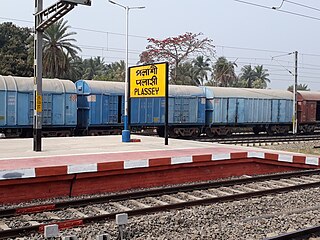
Palashi or Plassey is a village on the east bank of Bhagirathi River, located approximately 50 kilometres north of the city of Krishnanagar in Kaliganj CD Block in the Nadia District of West Bengal, India. The nearest major town is Beldanga. It has its own two local gram panchayat.

The Nawab of Bengal was the hereditary ruler of Bengal Subah in Mughal Empire. In the early 18th-century, the Nawab of Bengal was the de facto independent ruler of the three regions of Bengal, Bihar, and Orissa which constitute the modern-day sovereign country of Bangladesh and the Indian states of West Bengal, Bihar and Orissa. They are often referred to as the Nawab of Bengal, Bihar and Orissa. The Nawabs were based in Murshidabad which was centrally located within Bengal, Bihar, and Odisha. Their chief, a former prime minister, became the first Nawab. The Nawabs continued to issue coins in the name of the Mughal Emperor, but for all practical purposes, the Nawabs governed as independent monarchs. Bengal continued to contribute the largest share of funds to the imperial treasury in Delhi. The Nawabs, backed by bankers such as the Jagat Seth, became the financial backbone of the Mughal court. During the 18th century, the Nawabs of Bengal were among the wealthiest rulers in the world.

Mir Syed Jafar Ali Khan Bahadur was a commander-in-chief or military general who reigned as the first dependent Nawab of Bengal of the British East India Company. His reign has been considered by many historians as the start of the expansion of British control of the Indian subcontinent in Indian history and a key step in the eventual British domination of vast areas of pre-partition India.

William Watts was a British official with the East India Company. He was involved in the overthrow of the last independent ruler of Bengal, leading directly to the consolidation of Company rule in India and his own personal enrichment. Through his wife Begum Johnson, he had notable descendants, including a Prime Minister of the United Kingdom.

Kalikata was one of the three villages which were merged to form the city of Kolkata in India. The other two villages were Gobindapur and Sutanuti. Job Charnock, an administrator with the British East India Company is traditionally credited with the honour of founding the city. He settled in the village of Sutanuti.

Gobindapur was one of the three villages which were merged to form the city of Calcutta in late 17th century. The other two villages were Kalikata and Sutanuti. Job Charnock, an administrator with the British East India Company is traditionally credited with the honour of founding the city. While Kalikata and Sutanuti lost their identity as the city grew, Gobindapur was demolished for the construction of new Fort William.
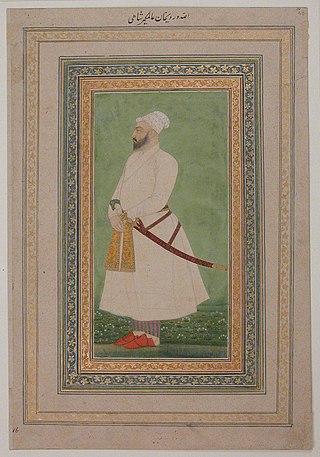
Alivardi Khan was the Nawab of Bengal from 1740 to 1756. He toppled the Nasiri dynasty of Nawabs by defeating Sarfaraz Khan in 1740 and assumed power himself.

Diwan Mohanlal of Purnia was a Hindu diwan serving under Siraj ud-Daulah, the Nawab of Bengal, at Murshidabad.
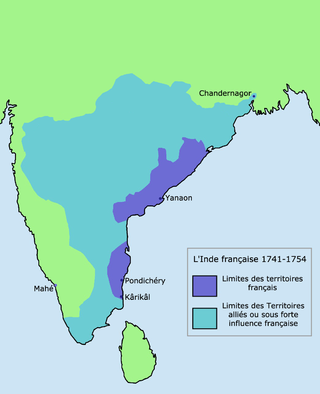
The siege of Calcutta was a battle between the Bengal Subah and the British East India Company on 20 June 1756. The Nawab of Bengal, Siraj ud-Daulah, aimed to seize Calcutta to punish the company for the unauthorised construction of fortifications at Fort William. Siraj ud-Daulah caught the Company unprepared and won a decisive victory.
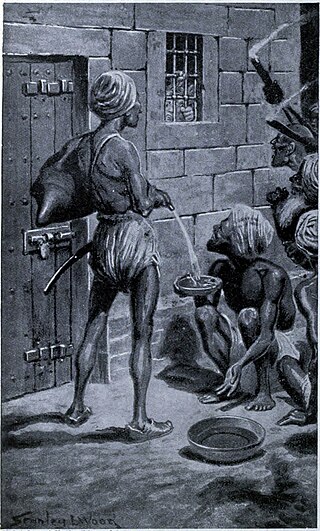
The Black Hole of Calcutta was a dungeon in Fort William, Calcutta, measuring 14 by 18 feet, in which troops of Siraj-ud-Daulah, the Nawab of Bengal, held British prisoners of war on the night of 20 June 1756. John Zephaniah Holwell, one of the British prisoners and an employee of the East India Company, said that, after the fall of Fort William, the surviving British soldiers, Indian sepoys, and Indian civilians were imprisoned overnight in conditions so cramped that many people died from suffocation and heat exhaustion, and that 123 of 146 prisoners of war imprisoned there died. Some modern historians believe that 64 prisoners were sent into the Hole, and that 43 died there. Some historians put the figure even lower, to about 18 dead, while questioning the veracity of Holwell's account itself.
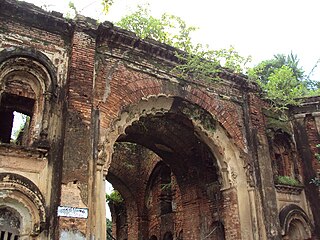
Namak Haram Deorhi was the palace of Mir Jafar. It is located just opposite to the Jafarganj Cemetery in the Lalbagh area of the town of Murshidabad and near Mahimapur in the Indian state of West Bengal. Namak Haram Deorhi refers to both the place of Mir Jafar and the main gate which leads to the palace. This building was used as the residence of Mir Jafar, before he ascended the musnad of Bengal or when he was the Commander-in-Chief of the subha.

Khushbagh is the garden-cemetery of the Nawabs of Bengal, situated on the west bank of the Hooghly river, about a mile from its east bank, in the Murshidabad-Jiaganj CD block in Lalbag subdivision of Murshidabad district, West Bengal, India. Khushbagh hosts the graves of the Nawabs of Bengal of the Afshar dynasty and their family members; while Jafarganj Cemetery hosts the graves of the later Nawabs and their families, starting from Mir Jafar, who belonged to the Najafi dynasty. Khushbagh is the resting place of Nawab Siraj ud-Daulah, his wife Lutf-un-nisa, Nawab Alivardi Khan, and his mother, amongst others.

Amina Begum was a Bengali aristocrat from the Nawab family of Bengal and mother of Siraj ud-Daulah, the last independent Nawab of Bengal.
Khoja Wajid was a wealthy Armenian merchant who played a prominent role in the economic and political life of Bengal in the 1740s and 50s.
References
- ↑ William Dalrymple, The Anarchy, Bloomsbury Publishing, 2020, p.76
- ↑ James Gordon Parker, The Directors of the East India Company, 17 54-1790, University of Edinburgh, 1977, p.92
- ↑ C. E. Buckland, Dictionary of Indian Biography, Ardent Media, 1971, p.123
- ↑ Provinces of British India - World Statesmen
- 1 2 3 4 J. Albert Rorabacher, Property, Land, Revenue, and Policy: The East India Company, C.1757–1825, Taylor & Francis, 13 Sep 2016, p.170
- 1 2 Daniel Baugh, Daniel A. Baugh, The Global Seven Years War 1754-1763: Britain and France in a Great Power Contest, Routledge, 22 Jul 2014, p.285
- 1 2 3 Hill, S. Charles, List Of Europeans And Others In The English Factories In Bengal, 1902, p.32
- ↑ John F. Riddick, The History of British India: A Chronology, Greenwood Publishing Group, 2006, p.131